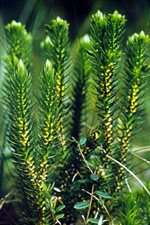The Club Moss Family
 |
 |
| Lycopodium clavatum |
Huperzia selago |
The Lycopodiaceae have a worldwide distribution, but are not present in arid habitats. Most of the family's diversity is in tropical montane and alpine areas. The family Lycopodiaceae consists of 10-15 genera and 350-400 species. Some of the most well known genera are Diphasiastrum, Huperzia, and Lycopodiella, the largest genus is Phlegmariurus of about 300 species. The specimen that we have studied in class is Lycopodium lucidulum.
Vegetative Characters | Reproductive Characters |
Diagnostic Characters | Economic Importance/Fun Facts
| Evolutionary Adaptations and Relationships | Glossary of Terms |
References and Links | Pictures
- terrestrial or epiphytic
- plants range from 5-20 cm tall
- dichotomous branching stems and roots
- rhizome with adventitious roots
- upright and lateral shoots are round or flat in cross section
- scale-like leaves which are microphylls, 0.2-2 cm long
- leaves needlelike to lanceolate to ovate
- microphylls are modified in the distinct strobili
Back to top
- homosporous
- spores subglobose to tetrahedral with a three branched scar
- sporangia reniform to globose, contain hundreds of spores
- sporangia solitary on upper surface of microphyll or aggregated in strobili
- distinct strobilus at end of stalk is more common, sporangia are more protected
- sporophylls unmodified and photosynthetic to highly modified, reduced, and non-photosynthetic when aggregated in terminal strobili
- bisexual gametophytes mycorrhizal, either surficial and photosynthetic or subterranean and nonphotosynthetic
- gametophytes depend upon a fungus for nutrition
Back to top
- dichotomous branching roots and stems
- leaves alternate, no petioles or ligules
- one solitary vein running down the leaf (or microphyll)
- herbaceous lacking secondary growth
- often referred to as resembling giant mosses
Back to top
- not significant economically
- the spore contains an oil that is highly flammable and was once used for flash powder
- the powder has been used in the past by magicians in the Middle Ages, as an early photography flash, and in early photocopy machine experiments
- ancient family of extreme diversity
- many species may still be undiscovered as tropical members of Phlegmariurus
- dominated the vegetation during a large part of the Carboniferous period
Back to top
- fossil record dates back to the Devonian
- specific and generic relationships are unclear
- large evolutionary gaps and morphological differences exist among the groups
- interspecific hybridization within genera makes distinctions difficult
- some of the differences are microscopic and difficult to even notice
- traditionally treated as just one genus, Lycopodium, but now divided
Back to top
- globose-globe shaped
- epiphytic-a plant growing attached to another plant, but not parasitic
- surficial-at the surface, not below ground
Back to top
- Judd et al., 1999. Plant Systematics: a phylogenetic approach. Sinauer Associates, Inc. Sunderland, MA U.S.A.
- Wagner, Warren H. Jr. and Joseph M Beitel, 1993. Flora of North America. Oxford Univ. Press. New York, NY U.S.A.
- http://www.rrz.uni-hamburg.de/biologie/b_online/fo45/lycocla.jpg
- http://www.murman.ru/flora/pictures/p300003.jpg
- http://www.mpiz-koeln.mpg.de/ ~stueber/lindman/
- http://www.borealforest.org/ferns/ground_cedar.jpg
- http://geography.berkeley.edu/.../ byFamiliesAll-in-1.html
Back to top
 |
 |
| Lycopodium complanatum, ground cedar |
spore showing trilete scar |
 |
 |
| Lycopodium selago |
Lycopodium complanatum |

Back to top
For questions or feedback, contact:
Kimberly Nelson







